Tag archives for: design

October 6, 2022 – The post-pandemic job hunt is in full swing, and for architects and interior designers, the demand is higher than the supply. With businesses reopening and new companies starting, there is a greater need for these professionals’ design services. If you are an architect or interior designer looking for a job, now is the time to start your search!
There are a few things that you can do to increase your chances of landing the job that you want. First, ensure that your resume and portfolio are up-to-date and highlight your experience in the industry. Next, reach out to your contacts and let them know you are looking for work. Don’t be afraid to apply for jobs outside your usual area of expertise; sometimes, the best opportunities come from unexpected places. Seek out a salary and compensation package that takes inflation into account. And finally, enlist a qualified placement firm on your behalf to uncover “hidden” openings.
With a little effort, you should be able to find the perfect job in this post-pandemic world. Good luck!
Do you have any tips for job hunting in the current market? Could you share them with us in the comments?
ABOUT THE AUTHOR
After working at various design practices on a full-time and freelance basis and starting his design firm, David McFadden saw a gap to fill in the industry. In 1984, he created an expansive hub for architects and hiring firms to sync up, complete projects, and mutually benefit. That hub was Consulting For Architects Inc., which enabled architects to find meaningful design work while freeing hiring firms from tedious hiring-firing cycles. This departure from the traditional, more rigid style of employer-employee relations was just what the industry needed – flexibility and adaption to current work circumstances. David has successfully advised his clients and staff through the trials and tribulations of four recessions – the early ’80s, the early ’90s, the early 2000s, the Great Recession of 2007, and the Pandemic.
The Job Hunt
|
architects, architecture, Consulting For Architects, David McFadden, demand, design, interiordesigners, jobhunt, jobs, pandemic, post, resume, supply, talent, Talent Shortage, unemployed architects
|

December 7, 2021 – Freelancers and Independent Contractors Beware: Build Back Better Vows to Impose the PRO Act Which Threatens Your Livelihood
The freedom to work as a freelancer or independent contractor provides flexibility for households and vibrancy to the American economy. It is tailor-made for architecture and design practices and freelance architects seeking to fill the peaks and valleys standard in architecture practices.
The PRO Act bans Right to Work laws nationwide. Still, it also imposes the same independent contractor/freelancer-destroying policies of California’s AB5 law, which has destroyed countless lives and driven people out of the Golden State.
Freelancers and independent contractors want to be their bosses. AB5 and the PRO Act dictate they must have a boss. Households need greater flexibility than ever after the changes brought about by COVID in the workplace.
I have been fighting my whole professional career for the right to freelance and become an independent contractor. We need to rally the political wing of AIA.org and ask their Advocacy group to engage and lobby against this provision of the Build Back Better bill.
Act Now Contact Sarah Dodge, AIA, Senior Vice-President of Advocacy & Relationships, and ask her to put the full force of the AIA’s advocacy group behind removing the AB5 provision out of Build Back Better!
[email protected]
Partial hat tip to the Freelancers Union
Freelance Community
|
AB5 Law, AIA.org, American Institute of Architects, architects, architecture, architecture practices, Build Back Better, Consulting For Architects, COVID, David McFadden, design, economy, Freelancers, freelancing, Independent Contractors, jobs, Livelihood, Pro Act, Workplace
|
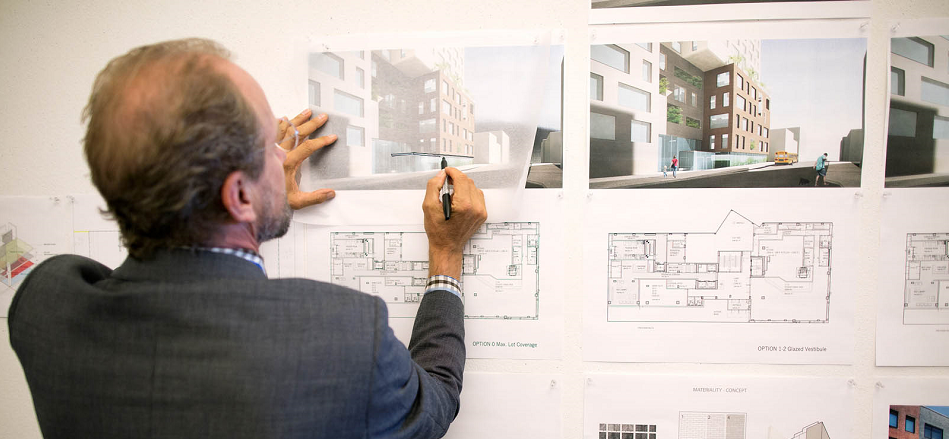
In our third installment of Archinect’s Guide to Job Titles series, we attempt to tackle the nuanced role of the Studio Director without falling back on search engines like Google and Bing or job boards like Glassdoor, Indeed, Monster, or Ladders [not in original article]. As with most positions within architecture firms, the lines are quite blurry when it comes to the role of Studio Director. For some, this leadership position acts as a kind of operations specialist and strategist while also functioning as a firmwide design leader. For others, the Studio Director might function as a buffer between design teams and the higher-level leadership of an organization. And for others still, this individual might run their studio as a kind of “mini-firm” within a larger firm, responsible for their own business development, hiring, project management, and overall growth. The intricacies and variations associated with such a dynamic posting can’t be explained exhaustively, there will always be some deviation. Nevertheless, what follows is our attempt to capture the inherent essence of this career path in architecture.
Structural Relevance
Architecture firms come in many forms. Depending on size, the internal structure of the personnel will differ. Some firms might operate in a departmental structure, where each team works on a specific phase of a project: a design “department” might work on the programming and schematic phases before passing the work on to a technical department that would realize the construction documentation. Others might have various project teams, each with its own project managers who are overseen by a Studio Director or Principal(s). And others still might divide into multiple studios, each with a specific function, and led by their own Studio Director, respectively. In this structure, each Studio Director would report to a Managing Principal, Design Principal, or both. Some Studio Directors may even be partners of the firm or Principals themselves. When it comes to the possible organizational structures of design firms, the variations are many.
While the interpretation of the role will differ from office to office, a Studio Director will typically oversee a studio. This may be a single studio under one roof, with a small or medium-sized staff, separated into smaller teams, each with a project architect/project manager, a job captain, and designers. Each team leader could report to a Studio Director who then might report to or collaborate with a higher-level leadership team, such as a firm’s Principal(s).
A studio could also be one of many within a larger firm, each with an expertise focus such as hospitality, healthcare, sports, workplace, restoration, or interiors. Each Studio Director would have specialized knowledge and experience in their area of expertise. In this model, studios might operate under the umbrella of a larger firm but would function as its own “sub-firm,” having its own clients, staff, and sometimes even its own receptionist. These “studio structures” can vary widely, and the nuances will depend on the organization in question.
A Studio Director Needs to be a People Person
In Archinect’s Growing Leadership and Practice: Laney LA’s Search for a Studio Director, we dove deep into conversation with Anthony Laney of Laney LA about his search for a Studio Director. “On day one, five project managers, each with their own team of one to two aspiring architects, will report to the Studio Director,” Laney told Archinect. “So, in total, the Studio Director will be leading a team of about 14 people. Right now, I’m giving about 30 percent of my time to a Studio Director role. We want to tear the lid off of that and allow someone to give it 100 percent of their time.” Here we have the leader of a relatively medium-sized firm in need of a Studio Director to act as a point person between him and his project managers. Laney saw this as someone who was not only in love with design, but who also had a deep passion for creating and building a great team.
People skills are 80 percent of the job, probably more…
Archinect also spoke with Lindsay Green, Principal and Studio Director at OFFICEUNTITLED, and Shawn Gehle, Principal and Co-Founder. On the topic of managing a team and dealing with different kinds of people, the pair elaborated further. “People skills are 80 percent of the job, probably more,” they said. “You have to deal with multiple personalities every day. Happy people; sad people; staff; clients; personal issues amongst the team.” They went on to articulate the expansive role a Studio Director might have within an office. In addition to effectively managing people, a leader in this role might also take on responsibilities of reviewing the office’s backlog and ensuring future staffing needs are fulfilled, overall professional development and client management, internal development of team members, human resources, and finance. “We really rely on Lindsay to run this office, we look to her to understand our overall health and outlook,” Gehle said of Green. “She acts as a kind of Chief Operations Officer, shepherding the resources within the office.”
A Strong Business Acumen
Green’s role goes far beyond that of the traditional project manager or project architect, but rises further into rigorous strategic planning and execution, calling for business acumen and facility not typical in architects. “I think if someone is considering this role as something to work towards in their career, they should consider getting an MBA. Understanding business is crucial in this position,” Green elaborated. “And even after that, it’ll take on-the-job experience to establish an understanding of how firms operate.”
Where before one’s core preoccupation might have been client satisfaction, design quality, timely deliverables, and internal team health, the focus now expands to a broader higher level concentration dealing with the business, strategic, and developmental aspects of the organization as a whole. Yes, project teams are concerned with these aspects, but on a fundamentally different level. They have a responsibility for their projects, whereas a Studio Director’s daily duties directly deal with the trajectory and direction of the bigger picture, moving beyond a partial focus to a comprehensive one.
What are firms looking for?
So what are firms looking for in a Studio Director? Take Gensler, a corporation based around a “collaborative studio leadership model.” Each studio has a specialty and is led by a highly experienced Studio Director, who oversees everything from overall management of the team and projects to the finances and budget. They work closely with staff in both professional development and mentorship as well as hiring in collaboration with HR. Studio Directors at Gensler are responsible for marketing, developing new business, and responding to RFPs, along with several other high-level responsibilities. According to Gensler, those pursuing this role should have a minimum of 15 years of experience and have a proven record in their area of focus. Moreover, Studio Directors at Gensler should possess a comprehensive personal portfolio of work, illustrating their aptitude and understanding of their expertise. Essentially, Studio Directors are leaders of their own small firm within the larger organization that is Gensler.
A Multi-Disciplined Leader
In the end, Studio Directors are multi-disciplined leaders with a depth of experience that allows them to lead a team of professionals of varying experience levels. They operate on multiple fronts, some of which include business functions such as staff development, hiring, strategic planning, finances, as well as traditional functions like QAQC, guiding design quality, and managing clients and projects. The possibilities appear broad and wide-ranging, but we’ve learned that business acumen is crucial, people skills are essential, and a deep understanding of the traditional functions of the architect, indispensable.
Author – Sean Joyner is an architect-trained writer and editor at Archinect. His articles and essays utilize themes in history, philosophy, and psychology to explore lessons for students and professionals within the fields of architecture and design. Sean’s work prior to Archinect focused primarily on k-12 and higher education projects in Southern California. Some of the things Sean enjoys are playing and practicing chess, studying obscure topics like quantum physics and cryptography, working out, and reading compelling books.
Sean Joyner’s Blog on Archinect
Archinect
Consulting For Architects, Inc. Staffing and Recruiting Hiring Trends Blog
Articles:
Salary and responsibilities for design directors for interior design
Harvard GSD announces winners of 2020 Richard Rogers Fellowship
Job Titles
|
Archinect, architecture, architecture jobs, Careers, Consulting For Architects, design, Gensler, Hiring, hiring an architect, hiring firms, ilookup, jobs, mentoring, studio, studio director, teaching, titles
|

No matter what you hope your destination will be, if you want to make a career out of architecture, it’s going to start with an entry-level job.
While that may not seem quite as exciting as your long-term goal, entry-level architecture jobs have a lot of potential if you know exactly how to approach them.
4 Ways to Make the Most Out of Entry-Level Architecture Jobs
Finding out you’ve been hired for your first architecture job is an absolutely incredible feeling.
However, don’t forget about the following four ways people have successfully taken full advantage of their entry level-architecture jobs, so you can make the most of this opportunity.
1. Consider the City the Job Is In
If you’re still applying for jobs, be sure to consider which city those jobs are in. Ideally, you want it to be a great city for architects, so you’ll be surrounded by opportunities.
That said, no matter where it is, brush up on your networking skills. This will help you on the job (more on that in a minute), but it will also go a long way toward helping you eventually find an even better role if you use these skills within your local industry.
2. Firm Up Your Soft Skills
Your duties as an architect include more than just preparing drawings and structure specifications.
Success will also depend on your soft skills, which include proficiency with:
- Team-building
- Communicating
- Problem-solving
Look for every opportunity in your entry-level role to sharpen these skills and the road ahead of you will become much easier.
3. Come Up with a 90-Day Plan
Every entry-level employee should come up with a 90-day plan to hit the ground running. This is especially true in architecture, though. You should also have a plan for the first week and the first month.
For example, during your first week, meet everyone on your team, department, or inside the entire firm, depending on its size. Become 100% clear on what your responsibilities are, too.
Over the first 30 days, finish meeting everyone if you haven’t already. Make it a point to ask at least one question a day, provided you genuinely don’t know the answer and you’re not slowing down your coworkers. It’s vital that you learn as much as possible.
During the first 90 days, you should look for a “mentor.” This doesn’t have to be an official capacity, but get a sense for whom – aside from your boss – you can learn the most from and keep asking them questions.
Of course, if they ever need help, go out of your way to repay their kindness.
Want Help Finding the Best Entry-Level Architecture Jobs?
As you can see, entry-level architecture jobs can be so much more than just an opportunity to get your foot in the door.
When you take the right approach, they can become a real launching point for the rest of your career. You may even be surprised to find just how quickly the above advice can bring you to your next step.
Of course, long before that happens, you need to land that first position. That’s where we come in. At Consulting For Architects, Inc. we’ve helped people just like you land their first jobs. Contact us today and let’s talk about how we can help you with your specific goals.

I have been having a lot of fun lately with Pinterest, a social bookmarking site where users collect and share photos of their favorite events, interests and promote their companies and services. I know many architect and design colleagues use Pinterest for these purposes and more, but wondered if you do too? Follow CFA on Pinterest!
Pinterest is the third-largest such network behind only Facebook and Twitter, and it is expanding in countries around the world. Of interest to us, most significant architecture publications and prominent architecture firms have a Pinterest account with multiple “Boards” with today’s architecture and design news or a firm’s latest work. A great example would be the online architecture magazine, Dezeen (Follow Dezeen on Pinterest»). Their latest Board is an ongoing collection of “best hotels” (See our new hotels Pinterest board»), which is very interesting. Two good examples of an architecture firm’s beneficial presence on Pinterest, are the popular work of Zaha Hadid and SOM. 100’s of Pinterest users who admire architecture or work in the field will “Pin” a project they admire. Just look at how popular the works of these two firms are among the Pinterest community Zaha Hadid and SOM
This post by Scott Meyer on Digital Homesteading titled, “Six ways Architects Can use Pinterest” breaks it down.
Six Ways Architects Can Use Pinterest
by Scott Meyer on October 19th, 2012
Pinterest is the fastest growing social network and there are many creative ways to use it for your business.
Fentress Architects from Colorado recently downloaded our most popular (and free!) ebook, The Advanced Guide to Pinterest. After reading it, they wrote to ask how architects specifically are using Pinterest. Let’s take a look at six ways architects are using Pinterest:
Architects on Pinterest
To kick it off, annharr87 provides a great slideshow highlighting some of the best practices for architects on Pinterest. As you can see, grouping styles of homes into boards creates an easy way for clients to browse fun and sometimes fantastical homes. Showcasing your homes is a key use of Pinterest.
Showcase Homes
View the slide show
Share interior design ideas
Another effective use of Pinterest is to help consumers with ways to improve their homes. MB Design in Vermont provides home improvement ideas as well as interior design ideas:
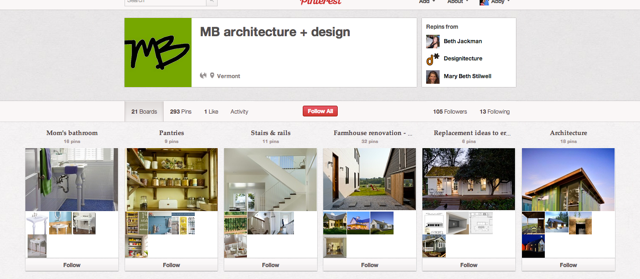
Provide Tips
This firm is doing a good job of giving viewers valuable resources that they can use on their own. These are the true drivers of traffic to bring users to your site. Once there, make sure you offer them valuable content and ways to capture their information as a lead. If you can follow-up with them and continue to offer advice, you’ll have them hooked.
Many “best ways to fix your (insert thing) in your home” type pins are shown below. These are great to get customers in your door.

Showcase work in bite-sized pieces
This firm, DxDempsey Architecture in Scranton, PA, is doing a wonderful job of organizing their pins and creating them to be very relevant to viewers. They are showcasing their own work, which is a key detail in winning customers. They show their home portfolio, retail stores, commercial properties, bathrooms, living rooms, etc, all that they designed themselves. This gives the consumers an idea of what they can achieve with DxDempsey.
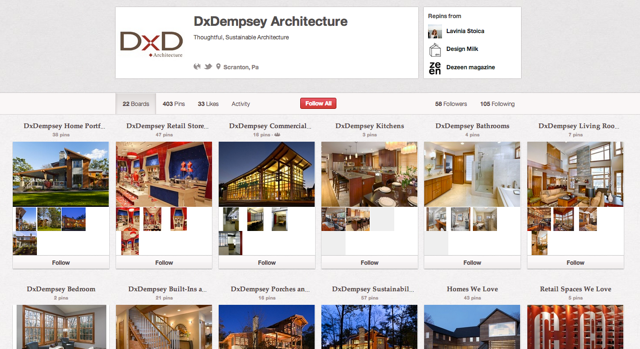
In addition, this will encourage customers to pin their finished DxDempsey spaces on their own pages, and link back to the company. This greatly increases visibility, especially when you consider that 85% of pins are repins.
Enable user-generated content
Consumer-generated content is very important for architecture firms, as they are highly reliant on their clients for feedback and popularity. By enabling them to upload their own content and link to your profile on Pinterest, as well as share your content on Pinterest, you will increase your website traffic and also customers will assign more credibility for your business as visuals communicate so much more than words.
Attract specific audiences
Another firm, TCA Architecture from Seattle, WA, knows what they are doing on Pinterest. They include a variety of board types, and they are showing the public that they truly care about the environment with their first board being “Sustainable Architecture.” This will appeal to the environmentally conscious customers and is a way for this firm to stand out among their competitors.
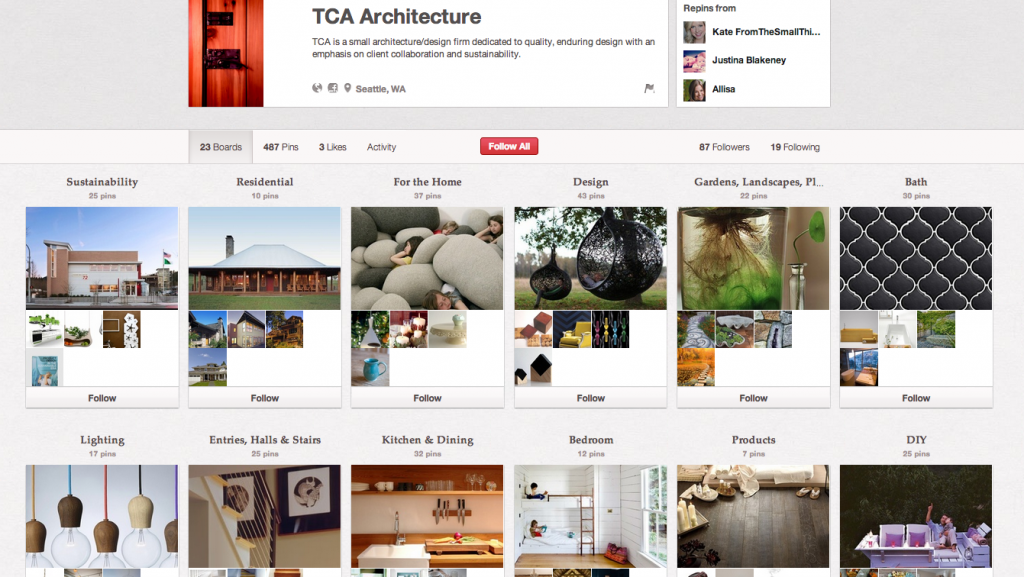
This firm is also doing a good job of showing architecture in a variety of lifestyle viewpoints, which gives them more reach with different types of customers and reminds viewers that everyone encounters architecture in their lives.
Pinterest for Architects
Pinterest is a perfect media to showcase architectural work. With the visual nature of architecture and the fact that it is the fastest growing social network, it should be at the center of any architectural firm’s social strategy.
My Recommendation: What are you waiting for?
Follow CFA on Pinterest! My two favorite boards lately are “Building I like today” and “Buildings I don’t like today”. Tell me what you think of my choices in the comment section.
Learn more
Need more help? Free resources to teach you how to use Pinterest along with the myriad of other social networks. Visit our resources page to download our free guides to social networks and digital marketing. You can also sign up for digital foundations class. This free email series will walk you through the most important concepts and networks for building a successful digital marketing strategy.
Related
Inside @Pinterest‘s beautifully spare new headquarters. http://f-st.co/J05eMfa pic.twitter.com/BXtoKe6yEb
The architects’ guide to Pinterest
What the Heck Is Pinterest and Why Should You Care? Let Us Tell You.
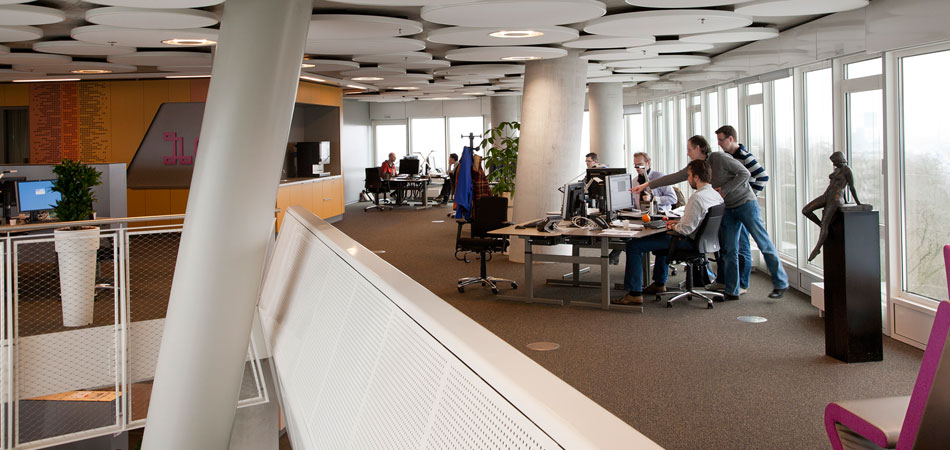
First, make an architecture or interior-design independent contractor into an employee by formalizing the person’s work arrangement and paying him or her regular wages. The IRS and its interpretation of payment and work plays the most important role in deciding a person’s status. At our staffing firm for architects and designers converting a independent contractor to a full-time employee is a third of our business.
Characteristics of an independent contractor
The IRS views an independent contractor as a person who works apart from the firm, and the rules governing them are not extremely clear cut. This wide room for interpretation has led to disputes in a number of workplaces. Fortunately, the status of an independent contractor is not as ambiguous as that of intern architect or draftsman.
By definition, an independent contractor is a person who has a significant amount of control over his or her work, achieves goals independently from the firm, doesn’t need to adhere to all the firm’s rules, uses his or her own equipment and doesn’t require close supervision by a member of the firm.
Characteristics of an employee
An employee must follow the set rules of the firm. He or she receives payment through a W-2 rather than a 1099 form. An employee uses the firm’s equipment to complete jobs, has a title with the firm and is subject to supervision by a member of the firm.
The transformation from contractors into employees
4 Key Points
- A person’s status changes when the firm takes them under its wing. Typically, this process involves the following aspects: training, giving the person authority to make decisions for the business, assigning the person key duties to perform and redefining the person’s work status as permanent, off-probation or retained for a set period of time. The process is complete when the new employee understands their work responsibilities and begins a project on behalf of the firm.
- It is critical that the person understand what it means when he or she has become an agent of the firm. The best way to accomplish this task is in writing. The new architect or interior designer and the owner of the firm should sign a letter of agreement stating the worker is now an employee.
- You can ratify and celebrate the change in a person’s status by providing them with business cards that state their title and contact information. Having a letter signed and dated by the owner that contains a start date is also helpful and thoughtful for those changing from independent contractors into employees.
- Finally, it is meaningful for the firm to circulate an internal announcement that they have hired the independent contractor as a full-time employee.
Source list:
http://www.cons4arch.com/
http://www.aia.org/akr/Resources/Documents/AIAB095064
https://www.mbopartners.com/resources/article/what-is-independent-consulting

Architecture Billing Index
Architecture firms anticipate relatively slow adoption rates for new and emerging technologies in design and construction
| By Kermit Baker, Hon. AIA, AIA Chief Economist |
U.S. architecture firms reported another solid month of growth in October 2015. The AIA’s Architecture Billings Index (ABI) was 53.1 for the month, demonstrating a solid increase in firm billings that was just below the 53.7 score for September. New project inquiries, with a score of 58.5 for the month, and new design contracts at 51.7, point to healthy business conditions at architecture firms. However, both readings fell a bit from their September level, suggesting that growth may moderate just a bit in the coming months.
 Click to expand The overall strong performance in business activity in recent months is beginning to show a regional pattern. Firms in the South have been reporting continued strong business conditions through the year, while firms in the West have been reporting acceleration in billings over the past few months. In contrast, Northeast firms have been reporting weak conditions in recent months, and Midwest firms—while reporting growth—have seen billings increase at a somewhat slower pace.
Firms in all the major construction sectors reported healthy conditions in October, with the strongest growth coming from commercial/industrial firms. Residential firms recorded their second straight monthly increase after seven straight monthly declines. Institutional firms saw growth on par with September, but their ABI scores have been declining for the past several months, indicating that the pace of growth of billings at these firms has been moderating.
In Spite of International Concerns, U.S. Economy Doing Well
The economy sputtered a bit in the third quarter, producing only 1.5% growth at an annualized basis. However, there appears to be some firming in economic conditions to date in the fourth quarter. There was a net increase of 271,000 payroll positions nationally in October, well above expectations, and the strongest monthly increase so far this year. That pushed the national unemployment rate down to 5.0%, its lowest level since early 2008. The construction sector has been an important contributor to the employment front, adding 31,000 payroll positions for October and 159,000 through the first ten months of the year. Construction has thus accounted for almost 8% of payroll gains so far in 2015.
An improving labor market, coupled with continued low gasoline prices, has improved the consumer’s outlook. The preliminary consumer sentiment index from the University of Michigan jumped up in November to its highest level in several months. This has produced higher levels of consumer spending, as retail sales—after netting the lower amounts spent on gasoline—saw healthy gains in October. A key test of the perceived health of the economy will come in mid-December when the Federal Reserve Board decides whether an increase in short-term interest rates is warranted to prevent potential future overheating.
Innovative Technologies May Not Yet Be Ready For Prime Time
In the design professions, as in other sectors in our economy, change is inevitable, but the pace of change may be slower than commonly thought. In an effort to see how the profession might be evolving over the coming five to ten years, this month’s question to the AIA’s Work-on-the Boards panel looked at design and construction elements that might be increasing in importance over this time period.
Topics covered included the areas of design and construction process and techniques, building characteristics, building features and systems, and construction materials. Several of the areas deemed to be becoming more widespread over this period are already fairly widely utilized, such as lighting technology systems (LED, day lighting/natural light), water conservation/efficiency, and energy efficiency designs and retrofits. The overwhelming majority of respondents felt that these design elements would be increasing in importance over the coming five to ten years.
However, other recent innovations that typically have garnered more attention may not reach the same levels of adoption over this period according to architecture firms. One example is the use of robotics in the construction process. Only one in nine respondents feels that this technology will significantly increase in importance over the next five to ten years. Conversely, about four in ten respondents feel that there were be no significant increase in this technology over the coming years. The results were not much different for 3D printing used in the construction process. Only about one in six respondents feels that this technology will significantly increase in importance in the coming years.
This month, Work-on-the-Boards participants are saying:
• After a late summer lull, clients seem to be back at their desks, making decisions and issuing RFPs and RFQs. Prospects for 2016 are looking up.
—33-person firm in the West, mixed specialization
• Firms are very busy and fees are slowly catching up with personnel salary increases.
—6-person firm in the South, institutional specialization
• Northeast (other than NYC) is still struggling to come out of the recession.
—4-person firm in the Northeast, mixed specialization
• New problem for us, long-predicted: talent shortage. Could increase staff by 15-20% if people were available. I expect this to last a long time.
—20-person firm in the Midwest, commercial/industrial specialization
Additional Resources:
Join the AIA Practice Management Knowledge Community to receive more practice-related content
Reference:
The ABI Work-on-the-Boards Survey Panel is open to any AIA member who is principal/partner of their firm. Apply to join the ABI panel by completing a brief background information form on your firm here.
Article originally posted on the AIA.org Website. |
Architecture Practice
|
aia, architects, architecture, Architecture Billing Index, Consulting For Architects, David McFadden, design, Economics, Federal Reserve, Fees, Inc, Labor Market, Salaries, Talent Shortage
|

Assembling a City
Perkins Eastman designs a city on the former site of an Atlanta car factory
The City of Doraville, population 8,300, is a 15-mile drive from downtown Atlanta. The suburban enclave is also the last stop on Atlanta’s METRO Gold line rail transit system. Around the station, Stan Eckstut, principal at Perkins Eastman, has designed a “city-within-a-city” on the 165-acre site of a former General Motors assembly plant, adding a heavy dose of transit-oriented walkability that developers at The Integral Group hope can entice city-centric millennials to the city’s fringe.
“It is a city, there’s no question,” Eckstut said of the development, dubbed “Assembly, Doraville, USA.” His master plan design—a mix of about 50-percent public space and 50-percent developable land sandwiched between railroad tracks and an interstate highway—embraces density around the Doraville transit stop, connecting to the city’s historic downtown with an armature of parks that will guide development over the next decade.
Eckstut said streets and public spaces organize development parcels, which are envisioned as fluid land-use designations rather than prescribed uses—much like in a real city. In turn, market forces guide what ends up getting built. Eckstut cautioned against the pitfalls of large-scale “Renaissance plans,” that guided 20th century urban renewal, and today have influenced heavy-handed development in China. “The issue is creating something that can be implemented over time with many ideas and many innovations,” said Eckstut. “You need to focus on how it will get implemented and how you can create a fabric where things can evolve and change—much like the grid of Manhattan.”
Assembly sits on one side of a 30-foot-tall freight and transit rail line, one of the busiest in the Southeast, and Doraville on the other. Eckstut said connecting the two was important to create a real urban place. He plans to build a 60-foot-wide tunnel beneath 13 active tracks, an expensive feat, to create connections that can also foster density.
“The plans that preceded us all had bridges that went over the tracks,” said Eckstut. The massive approach ramps required for such a structure precluded creating a compact town center. “I realized I could bring a street right under the tracks and meet up with grade. That became the whole scheme.” Eckstut said the street—an extension of Doraville’s civic heart, Park Avenue—will form the framework for the rest of the development. “This is the glue that connects the historical town center with the new 165-acre site,” he said.
Just inside, an approximately 1.7-acre “Transit Square” serves as the forecourt to the larger parks system. From here, everything in Assembly is an easy walk. “I drew a circle with a radius of about 1,200 feet—a five minute walk,” said Eckstut. “When you reach a five-minute walk, the world changes—people don’t walk after that.” You can get just about anywhere in Assembly in five minutes, and your walk will always be close by a park.”
Eckstut said that Assembly’s park system is a sustainable machine for the entire neighborhood. “Most large-scale projects today have one major sustainability challenge: keeping stormwater on site,” he said. “The best way of doing that is creating a park system. Wherever you have streets, you’re going to have rain gardens.” Rather than build wide sidewalks, Eckstut hopes these gardens will create a more intimate and vibrant streetscape.
Eckstut said streets and public spaces organize development parcels, which are envisioned as fluid land-use designations rather than prescribed uses—much like in a real city. In turn, market forces guide what ends up getting built. Eckstut cautioned against the pitfalls of large-scale “Renaissance plans,” that guided 20th century urban renewal, and today have influenced heavy-handed development in China. “The issue is creating something that can be implemented over time with many ideas and many innovations,” said Eckstut. “You need to focus on how it will get implemented and how you can create a fabric where things can evolve and change—much like the grid of Manhattan.”
Assembly sits on one side of a 30-foot-tall freight and transit rail line, one of the busiest in the Southeast, and Doraville on the other. Eckstut said connecting the two was important to create a real urban place. He plans to build a 60-foot-wide tunnel beneath 13 active tracks, an expensive feat, to create connections that can also foster density.
“The plans that preceded us all had bridges that went over the tracks,” said Eckstut. The massive approach ramps required for such a structure precluded creating a compact town center. “I realized I could bring a street right under the tracks and meet up with grade. That became the whole scheme.” Eckstut said the street—an extension of Doraville’s civic heart, Park Avenue—will form the framework for the rest of the development. “This is the glue that connects the historical town center with the new 165-acre site,” he said. Perkins Eastman
The City of Doraville, population 8,300, is a 15-mile drive from downtown Atlanta. The suburban enclave is also the last stop on Atlanta’s METRO Gold line rail transit system. Around the station, Stan Eckstut, principal at Perkins Eastman, has designed a “city-within-a-city” on the 165-acre site of a former General Motors assembly plant, adding a heavy dose of transit-oriented walkability that developers at The Integral Group hope can entice city-centric millennials to the city’s fringe.
“It is a city, there’s no question,” Eckstut said of the development, dubbed “Assembly, Doraville, USA.” His master plan design—a mix of about 50-percent public space and 50-percent developable land sandwiched between railroad tracks and an interstate highway—embraces density around the Doraville transit stop, connecting to the city’s historic downtown with an armature of parks that will guide development over the next decade.

Everywhere within the Assembly development is a five-minute walk away.
Eckstut said streets and public spaces organize development parcels, which are envisioned as fluid land-use designations rather than prescribed uses—much like in a real city. In turn, market forces guide what ends up getting built. Eckstut cautioned against the pitfalls of large-scale “Renaissance plans,” that guided 20th century urban renewal, and today have influenced heavy-handed development in China. “The issue is creating something that can be implemented over time with many ideas and many innovations,” said Eckstut. “You need to focus on how it will get implemented and how you can create a fabric where things can evolve and change—much like the grid of Manhattan.”
Assembly sits on one side of a 30-foot-tall freight and transit rail line, one of the busiest in the Southeast, and Doraville on the other. Eckstut said connecting the two was important to create a real urban place. He plans to build a 60-foot-wide tunnel beneath 13 active tracks, an expensive feat, to create connections that can also foster density.
“The plans that preceded us all had bridges that went over the tracks,” said Eckstut. The massive approach ramps required for such a structure precluded creating a compact town center. “I realized I could bring a street right under the tracks and meet up with grade. That became the whole scheme.” Eckstut said the street—an extension of Doraville’s civic heart, Park Avenue—will form the framework for the rest of the development. “This is the glue that connects the historical town center with the new 165-acre site,” he said.
 |
|
 |
|
 |
|
The Yards will be the first portion of the plan built.
|
Just inside, an approximately 1.7-acre “Transit Square” serves as the forecourt to the larger parks system. From here, everything in Assembly is an easy walk. “I drew a circle with a radius of about 1,200 feet—a five minute walk,” said Eckstut. “When you reach a five-minute walk, the world changes—people don’t walk after that.” You can get just about anywhere in Assembly in five minutes, and your walk will always be close by a park.”
Eckstut said that Assembly’s park system is a sustainable machine for the entire neighborhood. “Most large-scale projects today have one major sustainability challenge: keeping stormwater on site,” he said. “The best way of doing that is creating a park system. Wherever you have streets, you’re going to have rain gardens.” Rather than build wide sidewalks, Eckstut hopes these gardens will create a more intimate and vibrant streetscape.

Around the parks, the city has approved up to 10 million square feet of development governed by form-based codes that call for maintaining a street wall without setbacks for the first 60 feet of height. Eckstut said the tallest buildings around the Transit Square will top out at up to 15 stories, as dictated by the airspace requirements of an adjacent airport.
The first section of the plan to be built is called “The Yards” on the southwest corner of the site, where a spur of the rail line once entered the factory. Eckstut convinced developers to save leftover remnants from the old GM plant to be repurposed as a film studio. Perkins Eastman is also designing a new minimalist loft building with an industrial aesthetic adjacent to the studio. Cottage-like outbuildings will surround the studio and additional offices will fill train cars. Developers plan on breaking ground on The Yards within the next year.
With the master plan complete and approved, each of six distinct neighborhood districts will go through a separate site planning process that goes into more detail about buildings and public space design. The district surrounding Transit Square and including the new underpass will go into planning in the next 18 months. Eckstut said this phase “is very complicated because we have to engage the transit station and the street that goes under. It involves at least a dozen entities.”
Architectural Design
|
architects, Architects Newspaper, architecture, Atlanta Car Factory, design, development, Doraville, Manhattan, METRO Gold line rail transit system, Millennials, Stan Eckstuk
|

Firms Report Strongest Billing Since Before Recession
PHILADELPHIA (MNI) – U.S. architects are enjoying the fastest growth in billings since before the recession for their work on a range of residential and commercial construction projects, and expect continued growth in coming months, according to company owners and a trade association.
Architecture firms in Los Angeles, New York, and Charlotte, North Carolina said they have hired more people in recent months and expect to hire again to cope with the extra demand from developers of apartment buildings, retail space and in some cases institutional properties like charter schools.
While some companies have at least doubled their billing and the size of their payrolls since the depths of the recession, most said they have work in the pipeline that suggests even stronger revenue in 2015.
“This is really just getting underway,” said Kermit Baker, chief economist at the American Association of Architects, in an interview. “We are very much in the early innings of what looks to be a healthy recovery.”
The AIA’s monthly index of billing, which in July showed its strongest growth since mid-2007, is expected to show continued strength when the August index is released on Sept. 24, Baker said.
“I don’t think there’s any evidence that August was off that trend line significantly,” he said.
The industry has seen intermittent growth during the last three or four years so the evidence of a sustained upturn is not yet conclusive but the current increase is the strongest since the recession, Baker said.

The growth suggests there will be an upturn in non-residential construction spending of around 10% in 2015, Baker said. He attributes the upswing to improving business confidence and better access to capital.
“Businesses are finally at a stage where they are comfortable reinvesting in their facilities, and comfortable that the economic upturn is going to be sustained,” he said. “They are seeing sufficient demand to justify reinvestment.”
The greater availability of financing is allowing the restart of construction projects that stalled several years ago because of a tight credit environment after the recession.
“Financing has begun to ease up a little bit,” Baker said. “Surprisingly strong numbers of firms are saying they are now working on projects that they had begun three or four years ago, but stopped work and now they have come back.”
Even the market for design of institutions such as schools is coming back after a period when it was hurt by a decline in local government tax revenue.
“The last couple of months we have seen very strong numbers on the institutional side, which would suggest that construction activity moving into 2015 will begin to pick up,” Baker said.
The higher demand for institutional work has been seen in New York City where Caples Jefferson Architects is designing schools for both public and private-sector clients, as well as undertaking more work on residential projects.
“There are lots and lots of charter school construction going on right now as well as public construction,” said Sara Caples, president and principal of the firm in Long Island City.
Caples said demand for her firm’s services is at its strongest for at least five years, and that billing in the last few months has been about double its level of a year earlier. And in a sign that billings will growth further, she said she has had a “flood” of requests for proposals in recent months, and is responding to an unusually large number of them.
“We throw out a lot of requests for proposals if we don’t think we have a strong chance, and we’re still putting out a major proposal every week or so, which is just extraordinary,” she said.
Current projects include a 20,000 square-foot charter school in the Bronx, and a 40,000 square-foot charter school plus a 12-unit residential component in Manhattan, she said.
Residential developments are facilitating the construction of associated institutional projects because of the strong retail market in New York, Caples said.
“The market is strong enough that the residential makes it viable to build the six-story school on quite a challenging site,” she said. “The 12 residential units will allow them to pay off the mortgage very rapidly. The residential market seems to be the little engine that’s financing quite a lot of things.”
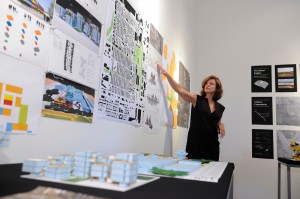
The eight-person firm already is two architects bigger than it was at the start of 2014, and may add more, despite an extremely selective hiring policy, if it takes on just one or two projects, she said.
The growth is being fueled by easier access to finance, which is helping not only to revive dormant projects but to launch new ones, Caples added.
“That’s what’s different about this,” she said. ‘Now, people are actually making new deals with their financiers that haven’t been kicking around forever.”
And she said her firm’s current growth seems to be representative of the market as a whole. “Most of the people that we talk to seem to be experiencing similar patterns,” she said.
In Charlotte, North Carolina, The Housing Studio, an architecture firm specializing in multi-family housing projects around the East Coast between Philadelphia and Charlotte, and in the Denver, Colorado area, is seeing an “explosion” in growth, said President Chuck Travis.
He said the company is billing about $3 million annually or more than three times the level during the recession. Its 28-strong work force is now about twice its traditional size, and four times its level at the low point of the recession. Travis said he’s looking to hire four or five more architects.
Travis said the growth is unprecedented in the company’s 18-year history. “It’s exponential growth in a two-year time frame,” he said.
He attributed the upswing to increased demand for rental housing in the walkable or transit-oriented urban areas that are favored by the “millennial” workers who eagerly sought by developers across the country.
That sector of the population is less interested in housing as an investment than was the previous generation, and prefers the flexibility of rented accommodation, he said, predicting continued growth.
“We’re not showing any signs of slowing down,” he said.
The demand for downtown living is also being seen in a three-square-mile area of Los Angeles, where 6,000 residential units are under construction and another 14,000-16,000 units are being planned, according to Simon Ha, a partner with TSK Architects.
That is creating more work for firms like TSK which is billing 30% more than it did a year ago, and has hired four architects this year for a total of 10, Ha said. And demand is stronger than it was in the pre-recession years of 2006-2007.
The construction boom, which he said is being fueled by investment from China, has resulted in land prices in the downtown area jumping to around $400 a square foot from $250-$300 two years ago. Land near LA’s Staples Center is now selling for about $600 a square foot, or about double its level two years ago, he said.
With a booming population of single people demanding housing in previously desolate urban areas like downtown LA, there are big opportunities for companies like TSK which has increased its billing for residential design to 70% of its total, Ha said.
By JON HURDLE, August 2014.
Search Careers
Request Talent
Join Mailing List

New Jet Age Design
 Dubai International Airport has surpassed Heathrow as the world’s busiest global hub, while three Gulf airlines—Emirates, Qatar Airways, and Etihad—are scooping up passengers. Boarding a lavishly appointed Airbus A380 at Dubai’s $4.5 billion Terminal 3, Graham Boynton examines the tectonic shift in aviation that threatens to leave the West’s cramped, bare-bones carriers in the dust.
Dubai International Airport has surpassed Heathrow as the world’s busiest global hub, while three Gulf airlines—Emirates, Qatar Airways, and Etihad—are scooping up passengers. Boarding a lavishly appointed Airbus A380 at Dubai’s $4.5 billion Terminal 3, Graham Boynton examines the tectonic shift in aviation that threatens to leave the West’s cramped, bare-bones carriers in the dust.
Two o’clock in the morning and I am standing at the crossroads of the modern world. Like a pinball machine, the arrivals-and-departures board clicks off the names of international cities—Dhaka, Colombo, Damascus, Male, Perth, Manchester, New York, Bangkok, Ho Chi Minh City—and wave after wave of citizens of the 21st century move this way and that through this massive marble-and-glass terminal.One can’t help staring in wonder. Denim-clad construction workers from the Indian subcontinent are slumped over seats waiting for their flights to be called; Armani-draped businessmen carrying Gucci leather briefcases head for the first-class lounges; young, loving couples sleep entwined on the sofas that line the walkways. The final call for the Emirates flight to Jidda summons a posse of women in burkas, who scurry to the gate. Walking in strict formation in the opposite direction, behind a young man hoisting a yellow flag, is a group of neatly dressed, middle-aged Japanese women.The only near-stationary beings in this enormous cavern of activity are the shoppers poring over items in 100 or so stores that run the length of the terminal, stacked with everything from the usual electronic gizmos and perfumes to $11,000 bottles of 1947 Cheval Blanc. (At Le Clos fine wines, the salesperson tells me she has already taken in $100,000—in a single sale—that evening.)And so the well-oiled people-moving machine keeps turning, 10 gigantic elevators shifting travelers up and down the terminal’s 11 floors, a subterranean train shuttling them between concourses, 82 moving walkways. Perpetual motion, 24–7, 365 days a year.This is Dubai International Airport’s $4.5 billion Terminal 3, the exclusive province of Emirates airline. Covering nearly 18.5 million square feet, it is the largest air terminal on the planet. Dubai International also ranks alongside Singapore’s Changi, Hong Kong International, and Beijing Capital International as the most passenger-friendly. Every week from this airport’s Jetways, 130 international airlines operate more than 6,000 flights to some 260 destinations on every continent except Antarctica it’s a new jet age.In January 2013, Dubai International opened Concourse A—aviation’s first facility dedicated entirely to Airbus A380 superjumbos. Located in Terminal 3, it is a magnificent building. Huge first- and business-class lounges connect directly to the A380 upper decks; economy-class passengers board from the lower level. The new concourse has already increased Dubai’s traffic to 75 million passengers a year, moving it past London’s Heathrow as the world’s busiest international airport. By 2018 that number is expected to pass 90 million, overtaking vast domestic hubs such as Atlanta and Beijing.
Take a look at the Airport in a 1-minute video!And yet this is just the beginning. A few miles across the tiny emirate another enormous, five-runway airport is under construction. For now, Dubai World Central serves partly as a cargo airport. But late in the next decade Emirates airline plans to transfer its operations there. The result: by 2025 more than 220 million travelers will be passing through the city’s airports annually. For Dubai, world domination is literally on the horizon.
On the Wing
Now follow these passengers onto one of the Emirates Airbus A380s. Emirates, owned by the government of Dubai, is one of the world’s fastest-growing international airlines and is a game changer in global travel. Together with the two other nouveau Gulf carriers, Qatar Airways and Abu Dhabi’s Etihad, the national airline of the United Arab Emirates, it has already made the European and North American warhorses of aviation seem down-at-heel and out of date. There are many reasons for their unlikely emergence out of these arid desert communities—oil first and foremost. But beyond this, there is the allure of the voyage. A passenger’s trip through the airport inspires a measure of wonder. And the magic-carpet experience on one of these aircraft is rather like checking into a small luxury hotel on the wing.
I join the stream of travelers transferring from the concourse to a shining new aircraft, around 400 boarding on the lower level into economy class and some 90 on the upper floor to business and first. On both tiers the passengers are greeted by a phalanx of attractive young air hostesses recruited from all over the world. (Though Emirates employs male stewards, none is in evidence today.) The cabin announcements reveal that the crew on this flight can speak English, French, German, Arabic, Spanish, Swahili, Mandarin, Italian, and Xhosa.
Although this is not my first A380 flight, I am still somewhat awestruck at how this 550-ton aircraft, after an almost silent and apparently effortless surge of its four Engine Alliance GP7200 engines, seems to float into the air after what appears to be a rather sedate rumble down the runway. Previously, my most vivid aviation experience had been on the Concorde, which, by dramatic contrast, rocketed across the tarmac at breathtaking speed and tinnitus-inducing decibels and scythed its way into inner space with all the romantic, devil-may-care optimism that defined life in the booming late-20th century. But this is commercial air travel in the credit-crunch 21st, and the A380 is a high-tech piece of aerospace pragmatism. Carrying 525 passengers up to 8,500 nautical miles nonstop (the Dubai-New York leg takes about 13 1/2 hours), the plane hums along in relative quiet—with astounding eco-correctness. Airbus claims that the A380 uses 20 percent less fuel than the Boeing 747, and that when fully laden and flying long-haul it is more fuel-efficient per passenger than a Toyota Prius.
The A380 is not a particularly pretty aircraft by the Concorde’s aesthetically pleasing standards; some airline buffs say it looks as if one bus has been squashed on top of another. But the space inside—the interior volume—is very impressive. The first-class cabin comprises 14 suites that are equipped with sliding doors for complete privacy as well as a vanity table, personal mini-bar, wardrobe, desk, 23-inch television screen, and what is effectively an armchair that converts into a bed. And if you want to take a shower at 40,000 feet, there are two of those on board. The food-and-wine menu is also appropriately lavish, with caviar, Dom Pérignon, Cakebread chardonnay, and 1989 Gruaud-Larose all standard fare.
At the back of the upper-deck cabin, directly behind business class, is the pièce de résistance: a fully operative stand-up bar that has been the social hub on every Emirates A380 flight I have taken. To make space for this in-flight lounge, Emirates president Tim Clark says, he has had to sacrifice six premium seats, but declares, “It’s the most popular thing we’ve ever done. They have a real party down there.” On this flight a group of Italian contractors join two British couples around the bar soon after takeoff. And they’re all still there six hours later as the plane starts its descent. It is, indeed, some party.
Even the humble masses in coach are able to partake of the A380’s in-flight video-and-audio system, which offers more than 1,500 channels featuring movies, television shows, news, games, and music from around the world, all delivered through high-end, 13-inch seatback monitors.
For anyone who has endured the post-deregulation austerity of U.S. airlines over the past few decades—uncomfortable, overcrowded, bare-bones bus journeys in the sky—the experience of flying on Emirates, Etihad, or Qatar comes close to recapturing the joy of jet travel from Pan Am’s heyday. There is a sense of fun on board, and that has come down from the top. Tim Clark says he wants to bring a bit of glamour back into flying.
The sudden ascendancy of the Gulf airlines and their hub airports is partially a result of geological fortune but mainly due to good planning by the Emirati leaders. Emirates was founded in 1985 after Sheikh Mohammed Bin Rashid Al Maktoum hired a British Airways executive, Sir Maurice Flanagan, gave him $10 million, and told him to build an airline. (Many start-up aviation firms begin by leasing most of their fleet.) Aware that Dubai’s oil reserves would run out in the early 21st century, Sheikh Mohammed had decided to transform his country from a petro-dependent mini-state to a diverse business powerhouse with tourism and aviation at its center.
Today the airline has some 218 aircraft, with another 374 on order. What Flanagan and Clark, another exile from the British aviation industry, have created is an airline that links the emerging countries in Asia and Africa to Europe and the Americas. As Clark points out, the U.A.E. is within eight hours’ flying time for half the world’s population. And just as Emirates was connecting Africa and the East to the rest of the world, so Emirates was joined by Qatar Airways in 1997 and then by Etihad in 2003 in its bid to shuttle this new generation of business and leisure travelers around the globe.
Four Tectonic Shifts
The emergence of these carriers marks the fourth tectonic shift in international aviation since Pan Am’s founder, Juan Trippe, democratized the industry in the early 1950s. Prior to Trippe’s intervention, air travel was the domain of the ruling classes, and fares between the U.S. and Europe were fixed by the stodgy International Air Transport Association. However, in 1952, Trippe decided to introduce a tourist-class fare between New York and London and thus began a decades-long battle between free-market flying and cartel-led regulation that would see the rise and fall of carriers such as Sir Freddie Laker’s Skytrain in the 70s and People Express in the 80s, along with the breakout success of Virgin Atlantic.
The second shift came with the arrival of the jet age, in 1958, the introduction of the Boeing 747 a little over a decade later, and then the 1978 deregulation of the U.S. airline industry. In the early days of mass air travel, national airlines such as Pan Am and TWA and flag-carrying European airlines (British Airways, Air France, Lufthansa) ruled the world through government-protected colonial-route networks. But as the colonies evaporated and new business models challenged regulation, the legacy U.S. behemoths began to fall. First Eastern, then Pan Am, then TWA.
Southeast Asia then heralded the third tectonic shift. Introducing high-quality, service-led air travel, airlines such as Cathay Pacific, Singapore Airlines, Thai, and the rest all flourished as the international business-travel market grew, and as the old-world airlines struggled to survive. These fleets provided more comfortable seating, particularly at the front of the cabins, and a level of in-flight service that Western airlines had failed to offer with any conviction since the 50s.
Now we are in the fourth age. U.S. airlines are merging and morphing into giant entities with large domestic networks and relatively small international reach, offering only passable amenities on rather old equipment. Meanwhile, the Gulf airlines feature quality service at a competitive price. Peter Morris, chief economist at the aviation consultancy firm Ascend, says that these carriers have now “built enough critical mass to be a genuine threat to the traditional European airlines and in the near future to the Americans.”
Shanghai on Steroids
‘They say that Dubai is Shanghai on steroids,” notes Clark as he stares out of his office window in the terminal, admiring a row of gleaming Emirates A380s. A neat, dapper man in his 60s, Clark reveals that his first job (after graduating with an economics degree from the University of London) was as a bus conductor. That humble beginning, he says, taught him the basics of the transport trade “because right from the start I was intrigued at the pricing structure and the type of bus fleet, and saw great similarities when I joined the airline industry.” He subsequently spent 14 years in aviation before moving to Dubai.
Emirates has 47 A380s in service and another 93 ordered, but the challenge of filling these giant aircraft as the world slowly emerges from the global recession doesn’t faze Clark at all. He says 93 is nowhere near enough for Emirates’ needs, and then his eyes light up at the thought of all the potential customers out there in the modern world. “Look at China,” he exclaims. “The Chinese market is big enough for all of us. There are cities we haven’t heard of—with populations half the size of Britain—and they’ve got three international flights a week.”
The only time that Clark seems to lose his air of affability is when criticism of Emirates is raised by the “legacy” airlines. He says that for years the leaders of these European and North American carriers have benefited from subsidies and tax advantages on fuel and had received export aid for new aircraft from Boeing and Airbus for which their domestic counterparts were ineligible. In any case, pleas to keep the trio of Gulf airlines out of Europe and North America have failed, and all three, over the past few years, have significantly increased service to European cities.
“The Europeans accuse us of stealing their market,” Clark says, fairly agitated. “But it wasn’t theirs in the first place. What right have they to take passengers from Africa to Asia or vice versa over European hubs? So a passenger who wants to go from Abidjan, the Ivory Coast, to Shanghai belongs to the European airlines? How can they claim that? The point here is that the number of people traveling between Shanghai and Côte d’Ivoire in the old days was probably five a week. Now it’s 5,000.
“The Americans,” he continues, “are similar to the Europeans in their archaic labor practices and processes and in the way companies are engineered internally. Some are trying to pull themselves into the 21st century. But we got there first.”
Bridging the Gulf
Eighty miles across the barren desert in Abu Dhabi is Clark’s opposite number, James Hogan, an Australian who for the past seven years has been the president and C.E.O. of Etihad. He oversees a kind of boutique version of the Dubai airline, with similarly excellent in-flight service, food and drink, and touch-screen digital entertainment. Etihad also has serious designs on the American market. The airline already runs daily flights between Abu Dhabi and New York, Chicago, and Washington, D.C. It has just started a similar L.A. service, and plans a Dallas route later this year.
Hogan is a more abrasive version of Emirates’ Clark, although his start in the travel industry was as humble as his rival’s: he was a check-in clerk working for Ansett Airlines in his native Australia and, like Clark, learned something about dealing with difficult airline passengers. He says he sees the future as the battle of the hubs—the Asian hubs, the European hubs, and, in the near future, the Chinese and Indian hubs. “One could call it the Old Silk Road being re-invented,” he says.
“Just look at India. There are some 300 million middle-class people there who are traveling, and the links, say, between India and America are strong. A lot of kids in these regions go to American universities, there are more American multi-nationals in the region, and the next opportunity is leisure travel.”
A number of frequent fliers I’ve spoken to say they prefer Etihad to Emirates because it has a more personal, intimate feel. As I board an Etihad Boeing 777 on the Abu Dhabi-London route I can barely tell the difference. Their flight crews, according to Hogan, come from 120 nations. Their average age is 26. The comfortable seats—all with digital entertainment systems—have 34-inch pitch in economy, 73 inches in business, and 80 inches in first, the latter classes offering lie-flat beds. The mood, even as we prepare for takeoff, is one of glamour and buoyancy. In a way, it reminds me of Virgin Atlantic in its youthful heyday, when the journey was an exhilarating part of the experience rather than a dread necessity.
There are many reasons for this spectacular rise of the Middle East airlines, but the impetus, above all, comes from the region’s political leaders’ putting their oil wealth to good use. Willie Walsh, C.E.O. of Europe’s International Airlines Group, looks on enviously from his offices at London’s Heathrow and says with barely concealed anger that “their governments recognize that airlines are a facilitator of economic development and growth. Whereas here [in the West], governments, through lack of commitment, vision, or policy, have seen air transport stagnate.”
And when the oil dries up? That really is the point of this supercharged growth spurt. While Dubai, in 2001, ranked 99th in international air traffic, it now ranks first. Whereas Emirati aviation, in the 90s, was a fledgling industry, today it represents 30 percent of Dubai’s G.D.P. This is a business that was certainly founded on a tidal wave of petrodollars. But now it has a life of its own. And, for the time being, all those flush travelers filling all those plush cabins seem increasingly grateful.






























